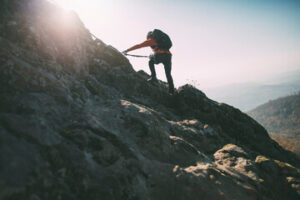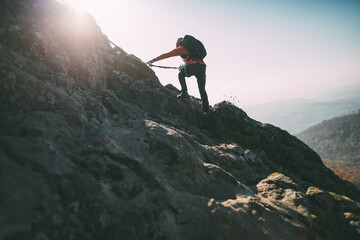Alta Climbing involves ascending natural or artificial rocks, ice, snow and even walls that are inside climbing gyms. It can seem daunting at first, with its specialized equipment and technical skills.
Outdoor climbers must contend with weather, bugs, falling rock and other hazards. Indoors, they only need to focus on the route ahead and follow climbing etiquette.
Climbing is a fun and challenging exercise that builds strength, endurance, and coordination. It is also a great cardiovascular workout that can improve your heart health. It also burns a lot of calories, and regular climbing can help you lose weight quickly. It is important to practice good technique and avoid injuries.
Many people who climb do so for the social connections, camaraderie, and the sense of accomplishment. It is a great way to get some exercise and feel more confident about yourself. In addition, climbing can also strengthen your muscles and bones and promote cognitive skills. It’s also a great way to get outdoors and connect with nature.
Rock climbing involves ascending a vertical surface with the help of a rope attached to your harness around your waist and a belay partner holding the other end. It is a great activity for the whole family and helps you build core and arm strength. It also improves your balance and flexibility. It’s a good idea to start with a belay class before trying your hand at the sport.
As you progress, your problem-solving abilities will improve. You will be able to figure out how to make each move work for you. This will help you overcome difficult challenges and become a better climber. Over time, you will be able to take on harder routes and achieve your goals.
Climbing requires a high level of strength and agility, and you can develop these skills through training. You can do this by training at moderate intensity. For example, you can use a route that is a grade or two below your flash level and train by climbing it for a predetermined amount of time and resting for an equal amount of time. This will simulate the work-to-rest ratio that you’ll encounter on your project routes.
It is important to note that you should not train at such a high intensity that it causes your muscles to fatigue and scream for you to stop. In addition, the fine motor skills required for climbing deteriorate first when you are tired, and this can lead to injury.
Mental challenge
As challenging as it is physically, climbing is an intensely mental sport. It requires an incredible amount of concentration, as even a momentary lapse in attention can have serious consequences. It also demands a willingness to tackle fear, a natural reaction to the inherent risks of the sport. Moreover, routes often resemble intricate puzzles that demand creative problem-solving skills. Conquering these mental hurdles enables climbers to push their limits and ascend more difficult ascents.
Climbing’s unique culture emphasizes support and camaraderie, fostering social resilience. As a result, the sport is often a platform for individuals to share their stories of struggle with mental health issues and how they’ve overcome them through a positive mindset. These stories serve as a valuable resource for anyone who may be struggling with their own personal challenges and seeks inspiration and encouragement to continue to climb.
While climbing is a fun and exciting pastime, it can also be extremely stressful. For this reason, it’s important to practice healthy coping mechanisms to avoid burnout and maintain peak performance. These techniques include deep breathing, visualization, and grounding exercises. They can help improve focus, reduce stress, and promote a healthy lifestyle.
One of the most common mental barriers faced by climbers is anxiety. This can be caused by a fear of falling or simply feeling unprepared for a climb. Climbers must learn to overcome this anxiety by training their minds to remain calm and focused during the climb. They also need to learn how to manage their emotions, such as fear, angst, frustration, and anger.
The most effective way to overcome these barriers is to practice mindfulness, which helps you stay present and engaged in the moment. This technique can be as simple as taking a deep breath and counting to four before exhaling. This method can instantly begin to calm the nervous system, quiet the mind, and relax the body. Moreover, it can also be used to train your brain to work faster and more efficiently under pressure. This can help you to perform better on a tough route, as well as in other challenging situations.
Social interaction
Climbing is a social activity that requires cooperation with other climbers. While this social interaction is a crucial aspect of the sport, some climbers may be too focused on their own success and neglect to consider the needs of others. This selfish behaviour is referred to as social climbing and can have detrimental effects on a climber’s performance and mental well-being.
The social climbing scale has supportive and empathic behaviour on one end, and egoistic and negative behaviour on the other. A climber’s social behaviour is influenced by both of these elements, and the most successful climbers are able to balance these factors. This balanced behaviour allows the climber to achieve maximum climbing performance.
The participants of this study found that egoistic behaviour often interfered with the enjoyment of the sport. They also felt that it could lead to the frustration of others, and resulted in a negative atmosphere within their climbing groups. In contrast, supporting behaviour was a positive factor for all participants, and they found it to be crucial to their own climbing performance.
Social climbing can lead to profound changes in a climber’s relationships, both in their immediate circle and in the larger community. Longstanding friendships may suffer from the social climber’s new priorities, while family members might feel neglected or resentful. Moreover, the pursuit of status can overshadow communal values and create a hierarchy in which social connections are transactional rather than genuine.
In addition to social climbing, climbers can be overly competitive with one another. They might snoop on their training partners to see how well they’re performing or to learn how to solve a difficult route. This behaviour is not only a source of stress, but it can also decrease a climber’s focus and concentration.
Climbers also engage in social climbing in absentia, where they talk about other climbers’ performances without actually being present. This type of behaviour can cause a lot of damage to people’s self-esteem and reputation. This is because high quality men and women will see through these tactics and think that the social climber is a loser trying too hard.
Outdoor adventure
Climbing is a sport that can take place outdoors on big mountains, small cliffs, or indoors. It can also involve ascending natural or man-made rocks, frozen streams of ice, snow, glaciers, or even the sides of buildings. It can be as simple as climbing a ten foot tall boulder in your backyard or as complex as summiting an 8,000 meter high mountain halfway around the world. Some climbing adventures require tons of specialized gear while others can be done with nothing more than a pair of sneakers and a rope.
The physical challenge of climbing can be a great way to increase your stamina. It can also help you learn to control your breathing and improve your balance. Additionally, climbing can be a great social activity for groups of people. It encourages team members to work together, communicate effectively, and support each other as they struggle to climb.
There are many different types of climbing, and the most popular type is outdoor rock climbing. It can be a short and easy route that you can do with your friends, or it can be a multi-pitch climb that requires more specialized equipment and safety procedures. In either case, it is a great opportunity to explore nature and experience the outdoors.
If you are new to outdoor rock climbing, it is recommended that you get some guidance from a guide before venturing out into the Gunks. The guides will provide you with the proper equipment and teach you how to use it. They will also make sure that you are safe on the rock face.
Another popular form of outdoor rock climbing is called free soloing, in which you climb without a rope and use a harness to prevent you from falling. This is a dangerous activity and should only be attempted by experienced climbers.

